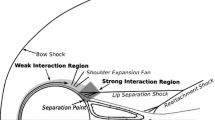Abstract
A unified supersonic/hypersonic theory is given of flow past a pitching oscillating double wedge airfoil at arbitrary mean angle of attack. The amplitude and the (reduced) frequency parameter of the oscillation are assumed small and a perturbation method is employed. Closed form formulae are obtained for the stiffness and damping-in-pitch derivatives. They are exact with respect to the free stream Mach number, angle of attack and body thickness etc., provided only that the bow shock is attached to the leading edge. The theory predicts negative damping (instability) if the angle of attack, or the airfoil thickness is sufficiently large, or if the free stream Mach number is sufficiently low. It is shown to be in good agreement with experiments of Scruton et. al. Comparisons with Van Dyke second order potential theory and with Lighthill piston theory are also given. Finally the theory may easily be extended to arbitrary smooth airfoils.
Résumé
On présente une théorie unifiée de l'écoulement supersonique/hypersonique instationnaire autour d'un profil mince à double dièdre en oscillation d'incidence, l'angle d'incidence moyen étant quelconque. L'écoulement est calculé à l'aide d'une méthode des perturbations en supposant que la pulsation réduite et l'amplitude de l'oscillation sont faibles. On obtient ainsi des relations pour les coefficients de stabilité et d'amortissement en tangage dont la solution — pour un nombre de Mach du courant non perturbée, une incidence et un épaisseur du profil données — est exacte pour tout écoulement sans décollement du choc au bord d'attaque. La théorie prédit une instabilité (amortissement négatif) lorsque l'angle d'incidence ou l'épaisseur du profil est suffisamment grande, ou lorsque le nombre de Mach est faible. L'accord avec les résultats expérimentaux de Scruton est bon. On présente également des comparaisons avec la théorie potentielle du second ordre de Van Dyke et la théorie de Lighthill. On conclut en observant qu'une extension de cette méthode au calcul de profils de forme quelconque est facilement réalisable.
Similar content being viewed by others
References
A. J. Eggers Jr., R. C. Savin, and C. A. Syvertson,The generalized shock-expansion method and its application to bodies travelling at high supersonic air speeds, J. Aeronautical Sci,22, 231–238, 248 (1955).
J. J. Mahony,A critique of shock-expansion theory, J. Aeronautical Sci,22, 673–680 (1955).
J. W. Miles,Potential theory of unsteady supersonic flow, Cambridge University Press, Cambridge 1959.
M. D. Van Dyke,Supersonic flow past oscillating airfoils including non-linear thickness effects, NACA report #1183 (1954).
M. J. Lighthill,Oscillating airfoils at high Mach number, J. Aeronautical Sci,20, 402–6 (1953).
G. Zartarian, P. T. Hsu and H. Ashley,Dynamic airloads and aeroelastic problems at entry Mach numbers, J. Aerospace Sci,28, 209–222 (1961).
W. H. Hui,Stability of oscillating wedges and caret wings in hypersonic and supersonic flows, AIAA J.,7, 1524–1530 (1969)
W. H. Hui,Supersonic/hypersonic flow past an oscillating flat plate at large angles of attack, J. Appl. Math Phys (ZAMP)29, 414–427 (1978).
W. H. Hui,An analytical theory of supersonic/hypersonic pitching stability, NATO AGARD Symposium on Dynamic Stability Parameters, CP-235, paper no. 22. (1978).
W. H. Hui, M. F. Platzer and E. Youroukos,Oscillating supersonic/hypersonic wings at high incidence, AIAA J,20, 299–304 (1982).
S. C. McIntosh Jr.,Hypersonic flow over an oscillating wedge, AIAA J,3, 433–440 (1965).
W. H. Hui,Interaction of a strong shock with Mach waves in unsteady flow, AIAA J,7, 1605–1607 (1969).
C. Scruton, L. Woodgate and K. C. Lapworth,Measurements of pitching-moment derivatives for aerofoils oscillating in two-dimenisonal supersonic flow, Aeronautical Research Council, R. & M. 3234 (1962).
W. H. Hui and M. Tobak,Bifurcation analysis of nonlinear stability of aircraft at high angle of attack, AIAA paper-82-0244 (1982).
Author information
Authors and Affiliations
Rights and permissions
About this article
Cite this article
Hui, W.H. Unified unsteady supersonic/hypersonic theory of flow past double wedge airfoils. Z. angew. Math. Phys. 34, 458–488 (1983). https://doi.org/10.1007/BF00944709
Received:
Issue Date:
DOI: https://doi.org/10.1007/BF00944709




